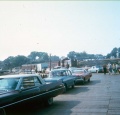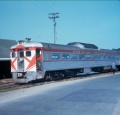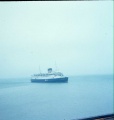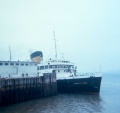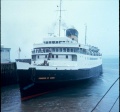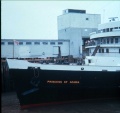Dominion Atlantic Railway Digital Preservation Initiative - Wiki
Use of this site is subject to our Terms & Conditions.
Difference between revisions of "Digby Wharf"
Dan conlin (talk | contribs) (→Gallery: image) |
Dan conlin (talk | contribs) (image) |
||
| Line 11: | Line 11: | ||
Image:DAR0025e.jpg|[[DAR0025|No. 25]] "Pontgrave" on shuttle run between Digby and wharf circa 1934. | Image:DAR0025e.jpg|[[DAR0025|No. 25]] "Pontgrave" on shuttle run between Digby and wharf circa 1934. | ||
File:CSTM-STR03993a 001 aa cs.jpg|[[DAR0023|No. 25]] "Pontgrave" at the [[Digby Wharf]], 1930s. | File:CSTM-STR03993a 001 aa cs.jpg|[[DAR0023|No. 25]] "Pontgrave" at the [[Digby Wharf]], 1930s. | ||
| + | File:00742.jpg|[[DAR0519|DAR Locomotive 519]] meeting [[SS Princess Helene]] at the [[Digby Wharf]], circa 1940. | ||
Image:DAR1111a.jpg|[[DAR1111|No. 1111]] backing onto [[Digby Wharf]] at [[Digby]] on July 3, 1954. | Image:DAR1111a.jpg|[[DAR1111|No. 1111]] backing onto [[Digby Wharf]] at [[Digby]] on July 3, 1954. | ||
Revision as of 17:51, 19 November 2016
Digby Wharf
The railway wharf at Digby was built about 1895 to connect DAR trains to the steamers serving Digby. A spur known as the "Dock Spur" led from the Digby Station to the wharf allowing both freight and passenger trains to connect directly with steamers. The wharf was steadily expanded over the years, most notably in the late 1920s for SS Princess Helene when a large freight shed and twin freight elevators were built. The DAR wharf remained in use into the dayliner era. However in 1971, with the arrival of the Princess of Acadia II, a new ferry terminal was built several miles out of town on Digby Gut, ending the DAR's railway to ship connection at Digby. However the DAR wharf was rebuilt for fisheries use, renamed the "Fishermen's Wharf". Today the fabric of the old DAR wharf remains a vital facility for the town of Digby today, despite neglect from an abortive privatization scheme in the 1990s.
Gallery
SS Prince Rupert meeting the train and landing passengers at the Digby Wharf.
Digby Wharf on right in background, Digby Railyard in foreground on left, circa 1930.
DAR Locomotive 519 meeting SS Princess Helene at the Digby Wharf, circa 1940.
No. 25 "Pontgrave" on shuttle run between Digby and wharf circa 1934.
No. 25 "Pontgrave" at the Digby Wharf, 1930s.
DAR Locomotive 519 meeting SS Princess Helene at the Digby Wharf, circa 1940.
No. 1111 backing onto Digby Wharf at Digby on July 3, 1954.
Digby Wharf in Digby. SS Princess Helene has just arrived from St. John, NB. Passengers boarding cars of Train No. 98 on July 3, 1954.
Loading passengers for Train No. 98 on Digby Wharf on July 3, 1954.
Loading passengers for Train No. 98, locomotive No. 1111 in front, on Digby Wharf on July 3, 1954. Observation car is No. 6616.
Digby Pines viewed from the Digby Wharf in 1954.
Buffet Parlor Observation car No. 6613 on the Digby Wharf behind loco No. 1050 on July 20, 1956.
Loco No. 1050 on the Digby Wharf with Parlor car No. 6613 behind on July 20, 1956.
SS Princess Helene arriving at Digby Wharf in Digby, NS from St John NB on August 27, 1958.
Digby Wharf with CPR equipment, as seen from SS Princess Helene, August 19, 1959.
Digby Wharf with CPR equipment, as seen from SS Princess Helene, August 19, 1959.
Steamer wharf, lighthouse, Digby Pines Hotel, freight cars and Digby Gap, from steamer, at Digby, NS. on August 19, 1959.
Dayliner No. 9059 & SS Princess Helene at Digby Wharf on August 19, 1959.
Louis Armstrong at the Digby Wharf arriving from Saint John on the Princess Helene in August of 1956.
DAR Dayliner No. 9058 at the Digby Wharf on 18th July 1959.
Passenger Extra with three coaches from Kentville led by SW1200RS No. 8133 picking up RCN recruits for HMCS Cornwallis at the Digby Wharf in the summer of 1966.
No. 9059 on the Digby Wharf to meet the Princess of Acadia in the summer of 1966.
No. 9059 on the Digby Wharf to meet the Princess of Acadia in the summer of 1966.
CPR Princess of Acadia at Digby Wharf in Digby, NS on July 17, 1975.
Princess of Acadia Docking Sequence
In these photos from the summer of 1966, "POA Digby Wharf 1966" photos 1, 2, 3, 4, 5, 6 & 7 show how they got the Princess of Acadia into the government wharf. She would steam slowly in and a line would be thrown to the wharf, they would tie it up on the post (bollard) at the end (photo 2, but seen much better in this shot from J.A.M. and this shot from J.A.M. as well) and she would rotate into the docking area. If you look carefully at the water currents in shot numbers 3 & 4 (the bows on shot), you will notice that she had a bow thruster (the eddies on the bow) added when she was refitted for St. John -Digby Service. Her predecessor the Princess Helene once was caught by the wind after she backed away from the wharf and it took her close to hour to get her bows pointed toward the gut. My father, who was much more nautical than I, described her as being "In-Irons". Sailing ships in this condition would launch a boat and the crew would then row or kedge her so the wind would catch the sails. The bow thruster eliminated this condition and made her quite handy to dock on her own or to turn her around at St. John.
References and Footnotes
External Links
- Nova Scotia Archives, Superb air view of Digby wharf, wharf spur and Princess Helene alongside, circa 1960
- Digby Wharf 1885, Admiral Digby Museum
- Admiral Digby Museum Memories Through Time Virtual Exhibit: Transportation, Wharf & Steamer Views
- Wondeful colour 8 mm film of DAR steam locomotives and RDCs at Digby Station and wharves with Princess of Acadia, 1950s, courtesy Admiral Digby Museum
- Family photo on Digby Warf with freight shed and boxcar in background



















